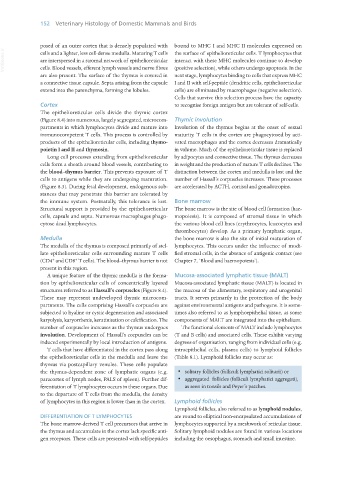Page 170 - Veterinary Histology of Domestic Mammals and Birds, 5th Edition
P. 170
152 Veterinary Histology of Domestic Mammals and Birds
posed of an outer cortex that is densely populated with bound to MHC I and MHC II molecules expressed on
VetBooks.ir cells and a lighter, less cell-dense medulla. Maturing T cells the surface of epithelioreticular cells. T lymphocytes that
are interspersed in a stromal network of epithelioreticular interact with these MHC molecules continue to develop
cells. Blood vessels, efferent lymph vessels and nerve fibres (positive selection), while others undergo apoptosis. In the
are also present. The surface of the thymus is covered in next stage, lymphocytes binding to cells that express MHC
a connective tissue capsule. Septa arising from the capsule I and II with self-peptide (dendritic cells, epithelioreticular
extend into the parenchyma, forming the lobules. cells) are eliminated by macrophages (negative selection).
Cells that survive this selection process have the capacity
Cortex to recognise foreign antigen but are tolerant of self-cells.
The epithelioreticular cells divide the thymic cortex
(Figure 8.4) into numerous, largely segregated, microcom- Thymic involution
partments in which lymphocytes divide and mature into Involution of the thymus begins at the onset of sexual
immunocompetent T cells. This process is controlled by maturity. T cells in the cortex are phagocytosed by acti-
products of the epithelioreticular cells, including thymo- vated macrophages and the cortex decreases dramatically
poietin I and II and thymosin. in volume. Much of the epithelioreticular tissue is replaced
Long cell processes extending from epithelioreticular by adipocytes and connective tissue. The thymus decreases
cells form a sheath around blood vessels, contributing to in weight and the production of mature T cells declines. The
the blood–thymus barrier. This prevents exposure of T distinction between the cortex and medulla is lost and the
cells to antigens while they are undergoing maturation. number of Hassall’s corpuscles increases. These processes
(Figure 8.3). During fetal development, endogenous sub- are accelerated by ACTH, cortisol and gonadotropins.
stances that may penetrate this barrier are tolerated by
the immune system. Postnatally, this tolerance is lost. Bone marrow
Structural support is provided by the epithelioreticular The bone marrow is the site of blood cell formation (hae-
cells, capsule and septa. Numerous macrophages phago- mopoiesis). It is composed of stromal tissue in which
cytose dead lymphocytes. the various blood cell lines (erythrocytes, leucocytes and
thrombocytes) develop. As a primary lymphatic organ,
Medulla the bone marrow is also the site of initial maturation of
The medulla of the thymus is composed primarily of stel- lymphocytes. This occurs under the influence of modi-
late epithelioreticular cells surrounding mature T cells fied stromal cells, in the absence of antigenic contact (see
+
+
(CD4 and CD8 T cells). The blood–thymus barrier is not Chapter 7, ‘Blood and haemopoiesis’).
present in this region.
A unique feature of the thymic medulla is the forma- Mucosa-associated lymphatic tissue (MALT)
tion by epithelioreticular cells of concentrically layered Mucosa-associated lymphatic tissue (MALT) is located in
structures referred to as Hassall’s corpuscles (Figure 8.4). the mucosa of the alimentary, respiratory and urogenital
These may represent undeveloped thymic microcom- tracts. It serves primarily in the protection of the body
partments. The cells comprising Hassall’s corpuscles are against environmental antigens and pathogens. It is some-
subjected to hyaline or cystic degeneration and associated times also referred to as lymphoepithelial tissue, as some
karyolysis, karyorrhexis, keratinisation or calcification. The components of MALT are integrated into the epithelium.
number of corpuscles increases as the thymus undergoes The functional elements of MALT include lymphocytes
involution. Development of Hassall’s corpuscles can be (T and B cells) and associated cells. These exhibit varying
induced experimentally by local introduction of antigens. degrees of organisation, ranging from individual cells (e.g.
T cells that have differentiated in the cortex pass along intraepithelial cells, plasma cells) to lymphoid follicles
the epithelioreticular cells in the medulla and leave the (Table 8.1). Lymphoid follicles may occur as:
thymus via postcapillary venules. These cells populate
the thymus-dependent zone of lymphatic organs (e.g. · solitary follicles (folliculi lymphatici solitarii) or
paracortex of lymph nodes, PALS of spleen). Further dif- · aggregated follicles (folliculi lymphatici aggregati),
ferentiation of T lymphocytes occurs in these organs. Due as seen in tonsils and Peyer’s patches.
to the departure of T cells from the medulla, the density
of lymphocytes in this region is lower than in the cortex. Lymphoid follicles
Lymphoid follicles, also referred to as lymphoid nodules,
DIFFERENTIATION OF T LYMPHOCYTES are round to elliptical non-encapsulated accumulations of
The bone marrow-derived T cell precursors that arrive in lymphocytes supported by a meshwork of reticular tissue.
the thymus and accumulate in the cortex lack specific anti- Solitary lymphoid nodules are found in various locations
gen receptors. These cells are presented with self-peptides including the oesophagus, stomach and small intestine.
Vet Histology.indb 152 16/07/2019 14:59

